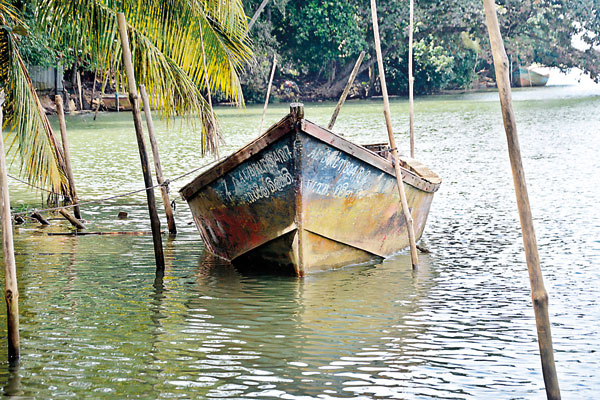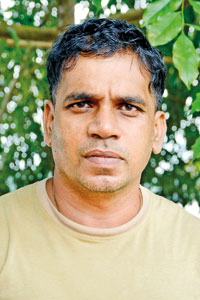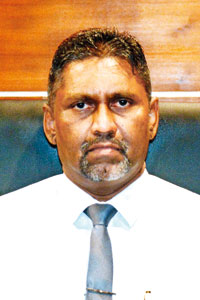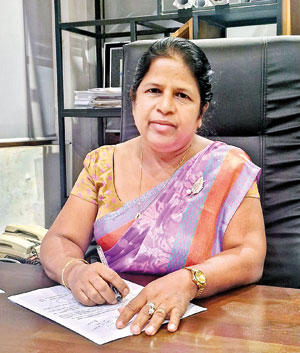News
Riverbed ravaged by reckless sand miners leaves Kalutara to confront fallout
View(s):By Tharushi Weerasinghe and Mimi Alphonsus
With environmental concerns prompting some agencies to push for a total ban, the DCC, chaired by legislator Dr Nalinda Jayatissa, is set to make a final decision on Friday (31). Sand mining in the Kalu Ganga, suspended in December, was reinstated in January pending the committee’s verdict.
The banks of the Kalu Ganga in Kalutara, are typically bustling with sand miners, boats, machinery, and lorries. However, during a recent visit by the Sunday Times, a discontented lull lay over the usually busy piers. Licences for mining along the river were halted sporadically over the last year with a final extension being granted up to December 31. The to and fro on the matter has left miners disgruntled.

The banks of the Kalu Ganga in Kalutara: Usually a hive of activity. Pix by Priyanka Samaraweera
“I have been mining here for the last 40 years and used to get my licence renewed annually, then it got renewed on irregular periods like three and six months before stopping altogether,” said Don Saman, 57, a sand miner. His permit expired in November. He claimed that sand mining creates a chain of employment in the community from miners and loaders to drivers. “I have about 15 people working for me at the moment and most of them have only done this their entire lives.”

Udaya Kumara, a sand miner
In Sri Lanka, the Geological Survey and Mines Bureau (GSMB) issues river sand mining licences following approvals from administrators of the river, which, in the case of the Kalu Ganga, is the Department of Irrigation, and Coastal Conservation Department (CCD).
In Kalutara, however, the National Water Supply and Drainage Board, the Road Development Authority and the Department of Railways have also been involved in the discussions due to the potential impact of mining on the railway bridge and the district water supply.
The Department of Irrigation has been advocating for an end to sand mining in the Kalu Ganga for nearly eight years, due to environmental and infrastructure damage.
“We brought the number of permits issued down from over 750 to 268 by removing the previous common approval method and introducing site visit approval systems in 2021 and cancelling multiple permits per person,” said Sudarshani Widanapathirana, director of irrigation, Colombo region. The Kalutara divisional engineer functions under her supervision.

Kalutara District Secretary Janaka Gunawardhana
Studies reveal a concerning degradation of the riverbed, particularly where the Kalu Ganga meets the sea. Between 2021 and 2024, the riverbed’s depth at the estuary increased from four metres below sea level to six metres. “A negative Mean Sea Level (MSN) at an estuary is common, but an MSN this high is abnormal and potentially dangerous,” Ms Widanapathirana explained. Over-mining worsens this issue, depleting sand faster than natural replenishment can occur, leaving the riverbed unable to recover.
The lowering of the riverbed has led to a gradual increased saltwater intrusion during the dry season, threatening the region’s water security. “Saline water moves upriver, and since the Water Board draws from the river, this becomes a critical problem,” Ms Widanapathirana noted. This will have an impact on agriculture and potable water sources. Recovery from such contamination is a slow and costly process, compounded by limited research on mitigation methods.
Riverbank erosion is another issue. “Infrastructure like the Kalutara railway bridge is at risk,” Ms Widanapathirana warned. Addressing bank erosion through protection measures, even the bare minimum solutions available such as those used on the Kelani Ganga, cost about Rs. 80 million for just 150 metres, according to the director.
The environmental impacts of sand mining ripple through the region’s water systems. During the dry season, the lower water levels reduce the groundwater table, causing wells to dry up and affecting agricultural productivity. “Groundwater recharge doesn’t occur when the riverbed deepens, and the area dries up faster during droughts,” Ms Widanapathirana explained. These issues also undermine flood mitigation efforts.
She noted that at present the department lacks critical resources to do studies necessary to safely validate any extraction. There are many vacancies in the department and only 100 engineers.

Sudarshani Widanapathirana, director of irrigation, Colombo region
She recommended that a university research team be reined in to study the sand deposit levels and recharge rates. “This is a temporary measure to recharge the system and assess the situation thoroughly,” she said.
The Department of Irrigation insists on temporarily banning sand mining in the Kalu Ganga, arguing that it is crucial for riverbed recovery and conducting critical studies. They cite widespread permit violations, with miners extracting beyond allowed limits, which are difficult to detect and control.
In 2024 the GSMB issued permits for the extraction of about 1,5000 cubic meters of sand every month. However, official government sources, and miners, acknowledge that the real numbers are significantly higher. “At least 50% of the mining that happens along this river is illegal,” claims Udaya Kumara, 45, another miner. He blames the rampant practice on expensive permit procedures and inefficient regulation. “The terms they give for permits is very irregular now,” said the businessman who suggested streamlining.
GSMB Chairman, Saman Jayasinghe, said that the district-level intervention in the Kalu Ganga sand mining issue was initiated due to the prevalence of illegal sand mining. He said that “in his view” an initial environmental examination should also be required for granting mining permits.
However, official sources involved in the technical discussions told the Sunday Times that some GSMB officers are pushing for the licences, claiming 600,000 cubes of sand are available for mining, with 80% viable for extraction. The Irrigation Department disputes this, citing flawed methodology that measures the entire riverbed rather than just extractable sand.
“We have asked the technical agencies to come to a consensus with a scientific basis to resolve the issue once and for all,” said Kalutara District Secretary Janaka Gunawardhana. He noted that while the mining had been halted due to recommendations of the Irrigation Department, social issues like loss of income prompted authorities to revisit the issue.
Demand for sand is on the rise as Sri Lanka’s US$8 billion construction industry recovers from the coronavirus epidemic and the economic collapse.
Nalin De Silva, head of Mining Surveys at the GSMB, told the Sunday Times that the country is struggling to meet the industry’s vast requirements and alternatives to river sand mining will have to be found fast.
In addition to disagreements over technicalities, the permit protocol for obtaining a sand mining license remains a contentious issue. Environmental lawyer Ravindranath Dabare emphasised that regardless of the decision taken by the District Coordination Committee, all legal procedures must be followed to obtain a mining license. This includes securing the consent of the river’s administrator, mainly the Department of Irrigation in this case.
Moreover, a Supreme Court ruling from 2024 called for mining licences to be granted through open bidding rather than the long-practised “first come, first serve” system, he explained. “This approach ensures the best price and better environmental protection,” he noted. He also alleged that cumulative sand mining areas are often divided into smaller sections to bypass the need for an environmental impact assessment (EIA).
EIAs, which are comprehensive studies of environmental consequences, are mandatory only for projects exceeding specific thresholds, such as minimum land area. While individual sand mining permits may fall below the required threshold, officials warned that grouped permits in clusters could have significant environmental impacts, especially in locations like the Kalu Ganga where clusters of multiple licences are high.
If the agencies continue to disagree, the policy deadlock will continue at next Friday’s (31) meeting. The heads of the relevant departments had contradictory views on whether GSMB could override the Department of Irrigation and issue licences without their approval.
The best way to say that you found the home of your dreams is by finding it on Hitad.lk. We have listings for apartments for sale or rent in Sri Lanka, no matter what locale you're looking for! Whether you live in Colombo, Galle, Kandy, Matara, Jaffna and more - we've got them all!

